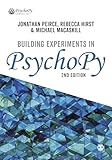Building Experiments in PsychoPy
Language: English Publication details: London SAGE 2022Edition: 2nd edDescription: ix, 299pISBN: 9781529741650 (PB)Subject(s): Psychology | Experimental Psychology | Introduction to Psychology | General BOOKS
BOOKS
| Current library | Home library | Call number | Materials specified | Status | Date due | Barcode |
|---|---|---|---|---|---|---|
| IMSc Library | IMSc Library | 159.9 PEI (Browse shelf (Opens below)) | Available | 77689 |
Includes References (290,291) and Index
1. Introduction
2. Building your first experiment
3. Using images: A study into face perception
4. Timing and brief stimuli: Posner cueing
5. Running studies online
6. Creating dynamic stimuli (revealing text and moving stimuli)
7. Providing feedback: Simple code components
8. Collecting survey data using forms
9. Using sliders
10. Randomizing and counterbalancing blocks of trials: A bilingual Stroop task
11. Using the mouse for input: Creating a visual search task
12. Implementing research designs with randomization
13. Coordinates and color spaces
14. Understanding your computer timing issues
15. Monitors and monitor center
16. Debugging your experiment
17. Pro tips, tricks, and lesser-known features
18. Psychophysics, stimuli and staircases
19. Building an FMRI study
20. Building an EEG study
21. Add eye tracking to your experiment
PsychoPy is an open-source (free) software package for creating rich, dynamic experiments in psychology, neuroscience and linguistics. It provides an intuitive graphical interface (the “Builder”) as well as the option to insert Python code. This combination makes it easy enough for teaching, but also flexible enough for all manner of behavioural experiments. As a result, PsychoPy has become the software package of choice in psychology departments at universities all over the world. Divided into three parts and with unique learning features to guide readers at whatever level they are at, this textbook is suitable for teaching practical undergraduate classes on research methods, or as a reference text for the professional scientist. The book is written by Jonathan Peirce, the original creator of PsychoPy and Michael MacAskill who have utilised their breadth of experience in Python development to educate students and researchers in this intuitive, yet powerful, experiment generation package.


There are no comments on this title.